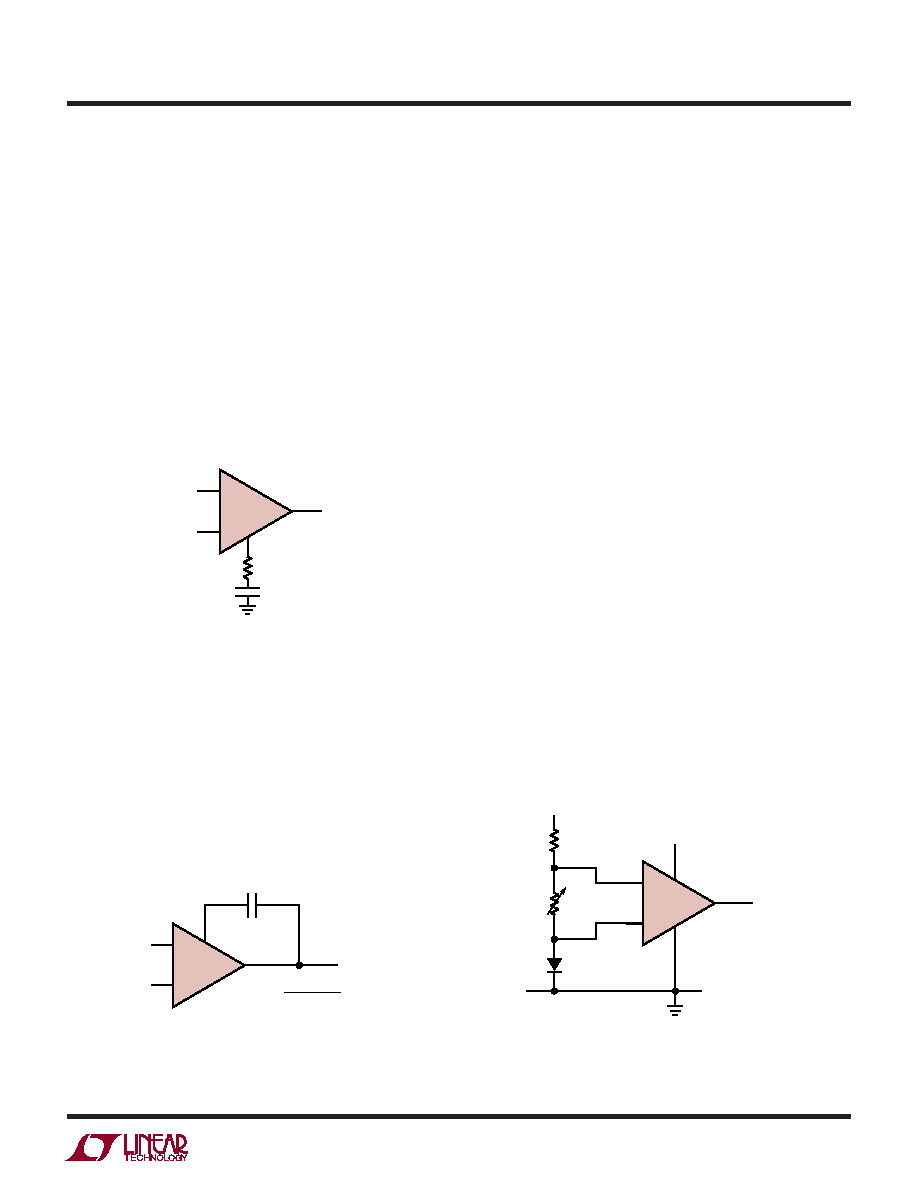- 您现在的位置:买卖IC网 > PDF目录2156 > LTC1100CSW#TRPBF (Linear Technology)IC INSTRMNT AMP CHOP-STBL 16SOIC PDF资料下载
参数资料
| 型号: | LTC1100CSW#TRPBF |
| 厂商: | Linear Technology |
| 文件页数: | 7/8页 |
| 文件大小: | 0K |
| 描述: | IC INSTRMNT AMP CHOP-STBL 16SOIC |
| 标准包装: | 1,000 |
| 系列: | LTCMOS™ |
| 放大器类型: | 断路器(零漂移) |
| 电路数: | 1 |
| 增益带宽积: | 18kHz |
| 电流 - 输入偏压: | 2.5pA |
| 电压 - 输入偏移: | 1µV |
| 电流 - 电源: | 2.4mA |
| 电压 - 电源,单路/双路(±): | 5 V ~ 16 V,±2.5 V ~ 8 V |
| 工作温度: | 0°C ~ 70°C |
| 安装类型: | 表面贴装 |
| 封装/外壳: | 16-SOIC(0.295",7.50mm 宽) |
| 供应商设备封装: | 16-SO |
| 包装: | 带卷 (TR) |

LTC1100
7
1100fc
Common Mode Rejection
Due to very precise matching of the internal resistors, no
trims are required to obtain a DC CMRR of better than
100dB; however, things change as frequency rises. The
inverting amplifier is in a gain of 1.01 (1.1 for gain of 10),
while the noninverting amplifier is in a gain of 99 (9 for gain
of 10). As frequency rises, the higher gain amplifier hits its
gain-bandwidth limit long before the low gain amplifier,
degrading CMRR. The solution is straightforward — slow
down the inverting amplifier to match the noninverting
amp. Figure 1 shows the recommended circuit. The prob-
lem is less pronounced in the LTC1100CS in gain-of-10
mode; no CMRR trims are necessary.
Figure 2. Overcompensation to Reduce System Bandwidth
100k
10pF
3
LTC1100 TA02
2
8
6
+
+
LTC1100
Figure 1. Improving AC CMRR
Overcompensation
Many instrumentation amplifier applications process DC
or low frequency signals only; consequently, the 18kHz
(180kHz for G = 10) bandwidth of the LTC1100 can be
reduced to minimize system errors or reduce transmitted
clock noise by using the COMP pin. A feedback cap from
COMP to VOUT will react with the 247k internal resistor
(22.5k for G = 10) to limit the bandwidth, as in Figure 2.
3
LTC1100 TA03
8
6
+
–
C
7
f
=
3dB
1
2
R
× C
π INT
R
= 247k FOR G = 100
22.5k FOR G = 10
INT
B
LTC1100
B
Aliasing
The LTC1100 is a chopper-stabilized instrumentation
amplifier; like all sampled systems it exhibits aliasing
behavior for input frequencies at or near the internal
sampling frequency. The LTC1100 incorporates special-
ized anti-aliasing circuitry which typically attenuates
aliasing products by ≥ 60dB; however, extremely sensi-
tive systems may still have to take precautions to avoid
aliasing errors. For more information, see the LTC1051/
LTC1053 data sheet.
Single Supply Operation
The LTC1100 will operate on a single 5V supply, and the
common mode range of the internal op amps includes
ground; single supply operation is limited only by the
output swing of the op amps. The internal inverting
amplifier has a negative saturation limit of 5mV typically,
setting the minimum common mode limit at 5mV/1.01 (or
1.1 for gain of 10). The inputs can be biased above ground,
as shown in Figure 3. Low cost biasing components can be
used since any errors appear as a common mode term and
are rejected.
The minimum differential input voltage is limited by the
swing of the output op amp. Lightly loaded, it will swing
down to 5mV, allowing differential input voltages as low as
50V (450V for gain of 10). Single supply operation
limits the LTC1100 to positive differential inputs only;
negative inputs will give a saturated zero output.
3
5V
LTC1100 TA04
8
6
+
OUTPUT
0V TO 5V
SENSOR
RBIAS
5
4, 1
5V
1N4148
LTC1100
Figure 3
Information furnished by Linear Technology Corporation is believed to be accurate and reliable.
However, no responsibility is assumed for its use. Linear Technology Corporation makes no represen-
tation that the interconnection of its circuits as described herein will not infringe on existing patent rights.
APPLICATIO S I FOR ATIO
WU
UU
相关PDF资料 |
PDF描述 |
|---|---|
| LTC1150CS8#TRPBF | IC OPAMP CHOP-STBL W/CAPS 8SOIC |
| LTC1151CSW | IC OPAMP ZERO-DRIFT DUAL 16SOIC |
| LTC1152CS8#TRPBF | IC OPAMP 0-DRFT R-R IN/OUT 8SOIC |
| LTC1992HMS8#TRPBF | IC AMP/DVR I/O FULLY DIFF 8-MSOP |
| LTC2050HVCS6#TRM | IC OPAMP ZERO-DRIFT SOT23-6 |
相关代理商/技术参数 |
参数描述 |
|---|---|
| LTC1100M | 制造商:LINER 制造商全称:Linear Technology 功能描述:Precision, Chopper-Stabilized Instrumentation Amplifier |
| LTC1100MJ | 制造商:未知厂家 制造商全称:未知厂家 功能描述:Instrumentation Amp, Fixed Gain |
| LTC1100MJ8 | 制造商:LINER 制造商全称:Linear Technology 功能描述:Precision, Chopper-Stabilized Instrumentation Amplifier |
| LTC1112CS8 | 制造商:Linear Technology 功能描述:1112CS8 |
| LTC1142 | 制造商:LINER 制造商全称:Linear Technology 功能描述:Dual High Efficiency Synchronous Step-Down Switching Regulators |
发布紧急采购,3分钟左右您将得到回复。